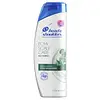Head & Shoulders Itchy Scalp Care with Eucalyptus Anti-Dandruff Shampoo Versus L'Oreal Crème Permanent Hair Color
What's inside
What's inside
 Key Ingredients
Key Ingredients

No key ingredients
 Benefits
Benefits

No benefits
 Concerns
Concerns

 Ingredients Side-by-side
Ingredients Side-by-side

Zinc Pyrithione 1%
AntiseborrhoeicWater
Skin ConditioningSodium Lauryl Sulfate
CleansingSodium Laureth Sulfate
CleansingGlycol Distearate
EmollientZinc Carbonate
Sodium Chloride
MaskingSodium Xylenesulfonate
Parfum
MaskingCocamidopropyl Betaine
CleansingDimethicone
EmollientSodium Benzoate
MaskingGuar Hydroxypropyltrimonium Chloride
Skin ConditioningMagnesium Carbonate Hydroxide
BufferingMentha Piperita Oil
MaskingMenthol
MaskingMentha Arvensis Leaf Oil
MaskingEucalyptus Globulus Leaf Extract
PerfumingMethylchloroisothiazolinone
PreservativeMethylisothiazolinone
PreservativeZinc Pyrithione 1%, Water, Sodium Lauryl Sulfate, Sodium Laureth Sulfate, Glycol Distearate, Zinc Carbonate, Sodium Chloride, Sodium Xylenesulfonate, Parfum, Cocamidopropyl Betaine, Dimethicone, Sodium Benzoate, Guar Hydroxypropyltrimonium Chloride, Magnesium Carbonate Hydroxide, Mentha Piperita Oil, Menthol, Mentha Arvensis Leaf Oil, Eucalyptus Globulus Leaf Extract, Methylchloroisothiazolinone, Methylisothiazolinone
Water
Skin ConditioningCetearyl Alcohol
EmollientGlycerin
HumectantTrideceth-5
EmulsifyingTrideceth-2 Carboxamide Mea
Hydrolyzed Oats
Skin ConditioningPolyquaternium-2
Chlorhexidine Digluconate
AntimicrobialPentasodium Pentetate
Oleamide
Ceramide AP
Skin ConditioningOctanediol
Ceteareth-7
EmulsifyingOleth-25
CleansingCitric Acid
BufferingHexadimethrine Chloride
Parfum
MaskingPropylene Glycol
HumectantDeceth-5
EmulsifyingLaureth-8
EmulsifyingPPG-12
Skin ConditioningAmmonium Hydroxide
BufferingOleth-2
EmulsifyingPPG-30
Skin ConditioningLauric Acid
CleansingGlycol Distearate
EmollientEthanolamine
BufferingSilica Dimethyl Silylate
EmollientCI 77891
Cosmetic ColorantPEG-4
HumectantAmino Esters-2
Skin ConditioningBHT
AntioxidantP-Aminophenol
Ascorbic Acid
AntioxidantSodium Metabisulfite
AntioxidantMethylal
Solvent2-Methyl-5-Hydroxyethylaminophenol
Ammonium Thiolactate
Dimethicone
EmollientProline
Skin ConditioningP-Phenylenediamine
Carbomer
Emulsion StabilisingThreonine
Resorcinol
AntioxidantEDTA
Hydrogen Peroxide
AntimicrobialSodium Salicylate
PreservativePhosphoric Acid
BufferingTetrasodium Etidronate
Emulsion StabilisingTetrasodium Pyrophosphate
BufferingBehentrimonium Chloride
PreservativeAmodimethicone
Cetyl Esters
EmollientIsopropyl Alcohol
SolventHibiscus Sabdariffa Flower Extract
Skin ConditioningSodium PCA
HumectantHydroxypropyltrimonium Hydrolyzed Wheat Protein
Skin ConditioningPPG-6
Skin ConditioningChlorhexidine Dihydrochloride
AntimicrobialSoluble Collagen
HumectantPanthenol
Skin ConditioningCandelilla Cera
EmollientCetrimonium Chloride
AntimicrobialWater, Cetearyl Alcohol, Glycerin, Trideceth-5, Trideceth-2 Carboxamide Mea, Hydrolyzed Oats, Polyquaternium-2, Chlorhexidine Digluconate, Pentasodium Pentetate, Oleamide, Ceramide AP, Octanediol, Ceteareth-7, Oleth-25, Citric Acid, Hexadimethrine Chloride, Parfum, Propylene Glycol, Deceth-5, Laureth-8, PPG-12, Ammonium Hydroxide, Oleth-2, PPG-30, Lauric Acid, Glycol Distearate, Ethanolamine, Silica Dimethyl Silylate, CI 77891, PEG-4, Amino Esters-2, BHT, P-Aminophenol, Ascorbic Acid, Sodium Metabisulfite, Methylal, 2-Methyl-5-Hydroxyethylaminophenol, Ammonium Thiolactate, Dimethicone, Proline, P-Phenylenediamine, Carbomer, Threonine, Resorcinol, EDTA, Hydrogen Peroxide, Sodium Salicylate, Phosphoric Acid, Tetrasodium Etidronate, Tetrasodium Pyrophosphate, Behentrimonium Chloride, Amodimethicone, Cetyl Esters, Isopropyl Alcohol, Hibiscus Sabdariffa Flower Extract, Sodium PCA, Hydroxypropyltrimonium Hydrolyzed Wheat Protein, PPG-6, Chlorhexidine Dihydrochloride, Soluble Collagen, Panthenol, Candelilla Cera, Cetrimonium Chloride
Ingredients Explained
These ingredients are found in both products.
Ingredients higher up in an ingredient list are typically present in a larger amount.
Dimethicone is a type of synthetic silicone created from natural materials such as quartz.
What it does:
Dimethicone comes in different viscosities:
Depending on the viscosity, dimethicone has different properties.
Ingredients lists don't always show which type is used, so we recommend reaching out to the brand if you have questions about the viscosity.
This ingredient is unlikely to cause irritation because it does not get absorbed into skin. However, people with silicone allergies should be careful about using this ingredient.
Note: Dimethicone may contribute to pilling. This is because it is not oil or water soluble, so pilling may occur when layered with products. When mixed with heavy oils in a formula, the outcome is also quite greasy.
Learn more about DimethiconeGlycol Distearate serves as a pearlizing or opacifying agent in cosmetic products.
It's often included in cleansers and haircare products to give them a lustrous or shimmering appearance.
It is derived from stearic acid, a natural fatty acid commonly found in vegetable oils and animal fats.
Glycol Distearate isn't fungal acne safe.
Learn more about Glycol DistearateParfum is a catch-all term for an ingredient or more that is used to give a scent to products.
Also called "fragrance", this ingredient can be a blend of hundreds of chemicals or plant oils. This means every product with "fragrance" or "parfum" in the ingredients list is a different mixture.
For instance, Habanolide is a proprietary trade name for a specific aroma chemical. When used as a fragrance ingredient in cosmetics, most aroma chemicals fall under the broad labeling category of “FRAGRANCE” or “PARFUM” according to EU and US regulations.
The term 'parfum' or 'fragrance' is not regulated in many countries. In many cases, it is up to the brand to define this term.
For instance, many brands choose to label themselves as "fragrance-free" because they are not using synthetic fragrances. However, their products may still contain ingredients such as essential oils that are considered a fragrance by INCI standards.
One example is Calendula flower extract. Calendula is an essential oil that still imparts a scent or 'fragrance'.
Depending on the blend, the ingredients in the mixture can cause allergies and sensitivities on the skin. Some ingredients that are known EU allergens include linalool and citronellol.
Parfum can also be used to mask or cover an unpleasant scent.
The bottom line is: not all fragrances/parfum/ingredients are created equally. If you are worried about fragrances, we recommend taking a closer look at an ingredient. And of course, we always recommend speaking with a professional.
Learn more about ParfumWater. It's the most common cosmetic ingredient of all. You'll usually see it at the top of ingredient lists, meaning that it makes up the largest part of the product.
So why is it so popular? Water most often acts as a solvent - this means that it helps dissolve other ingredients into the formulation.
You'll also recognize water as that liquid we all need to stay alive. If you see this, drink a glass of water. Stay hydrated!
Learn more about Water